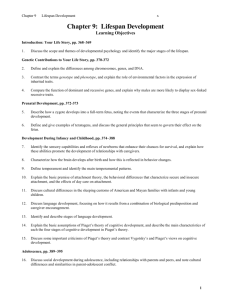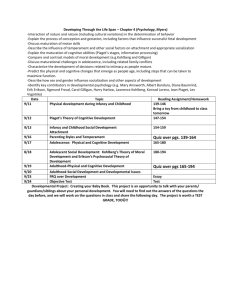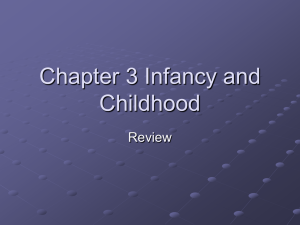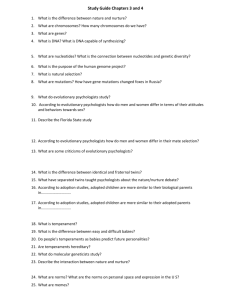Psychology and You
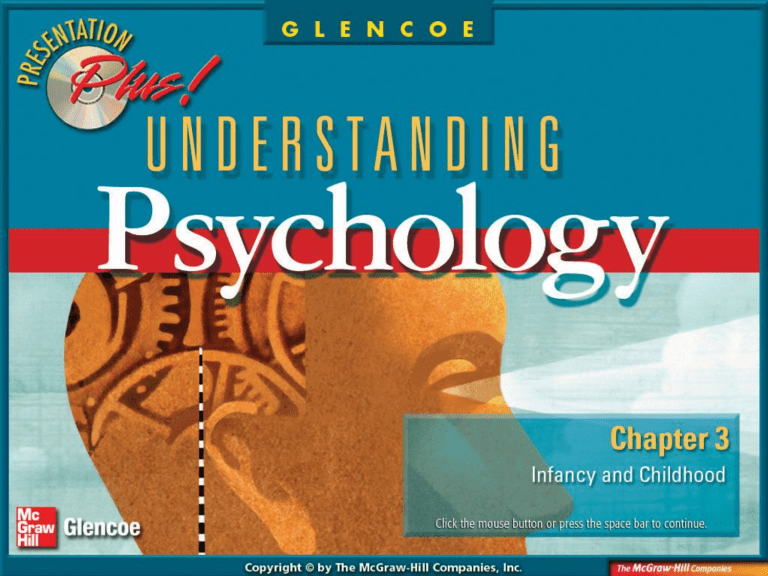
Splash Screen
Section 1:
Section 2:
Section 3:
Chapter Menu
Chapter Objectives · Section 1
Physical, Perceptual, and
Language Development
Understand that as infants grow physically, they also develop cognitive skills, perceptions, and language.
Chapter Preview 1
Chapter Objectives · Section 2
Cognitive and Emotional
Development
Discuss how as the thought processes of children develop, they begin to think, communicate and relate with others, and solve problems.
Chapter Preview 2
Chapter Objectives · Section 3
Parenting Styles and Social
Development
Describe the social decisions children face as they grow and progress through the stages of life.
Chapter Preview 3
Chapter Preview-End
Main Idea
Infants are born equipped to experience the world. As infants grow physically, they also develop cognitive skills, perceptions, and language.
Section 1-Main Idea
Vocabulary
• developmental psychology
• grasping reflex
• rooting reflex
• maturation
• telegraphic speech
Section 1-Key Terms
Objectives
• Describe the physical and perceptual development of newborns and children.
• Discuss the development of language.
Section 1-Objectives
How old are you in your earliest childhood memory?
A.
One or two
B.
Three or four
C.
Five
D.
Six or older
A. A
B. B
A
0%
B
D. D
0%
D
Section 1-Polling Question
Nature and Nurture
• Developmental psychology —the study of changes that occur as an individual matures.
• Developmental psychologists study:
– Continuity versus stages of development
– Stability versus change
– Nature versus nurture
Section 1
Do you believe that our behavior is inherited or due to the environment around us?
A.
Inherited
B.
Environment
C.
Both
D.
Not sure
A. A
B. B
A
0%
B
D. D
0%
D
Section 1
Newborns
• Babies are born with certain reflexes:
– Grasping reflex
– Rooting reflex
Section 1
Which of the following is NOT typical of a newborn?
A.
Crying
B.
Talking
C.
Sucking
D.
Sleeping
A. A
B. B
A
0%
B
D. D
0%
D
Section 1
Physical Development
• Within two years an infant transforms into a little boy or girl with many capabilities.
• This is due to:
– Maturation
– Learning—a relatively permanent change in behavior that occurs as a result of experience.
Section 1
Physical Development
(cont.)
• Psychologists have been able to develop an approximate timetable for maturation, which helps doctors and other professionals spot problems.
• Each child is unique, so the age range on some milestones varies.
Physical and Motor
Development
Section 1
At what age would you expect an infant to start crawling?
A.
8 –9 months
B.
10 –11 months
C.
12 months or more
A. A
B. B
0% 0%
A B C
Section 1
Perceptual Development
• Newborns have mature perception skills.
– They prefer human faces and patterned materials.
– They benefit from being held and touched by their parents.
– Infants older than 6 months display depth perception.
The Visual Preferences of Infants
Section 1
At what age do newborns display depth perception?
A.
3 months
B.
6 months
C.
9 months
D.
12 months
A. A
B. B
A
0%
B
D. D
0%
D
Section 1
The Development of Language
• Chimpanzees develop at least as far as a
2 year-old-human; however, they cannot apply grammatical rules.
• Grammar —a set of rules for combining words into phrases and sentences to express an infinite number of thoughts that can be understood by others.
Section 1
The Development of Language
(cont.)
• Psychologists argue over whether language is reinforced or inborn.
• Some people also claim that there is a window of opportunity for learning language.
Section 1
The Development of Language
(cont.)
• Steps to learning language:
– A person must learn to make signs, either by hand or mouth.
– He or she must learn the meaning of the signs.
– Then he or she must learn grammar.
Section 1
The Development of Language
(cont.)
• At the age of 2, a child’s language is known as telegraphic speech —the kind of verbal utterances in which words are left out, but the meaning is usually clear.
• Once children begin to learn grammatical rules, they tend to overgeneralize those rules until they truly understand them.
The Flowering of
Language
Section 1
Do you think that language is learned, innate, or both?
A.
Learned
B.
Innate
C.
Both
0%
A. A
B. B
0%
A B C
Section 1
Section 1-End
Main Idea
As the thought processes of children develop, they begin to think, communicate and relate with others, and solve problems.
Section 2-Main Idea
Vocabulary
• schema
• assimilation
• accommodation
•
• egocentric imprinting
• object permanence
• representational thought
• conservation
• critical period
Section 2-Key Terms
Objectives
• Summarize the cognitive-development theory.
• Discuss how children develop emotionally.
Section 2-Objectives
What age do you think babies start communicating?
A.
Immediately after birth
B.
After 3 months
C.
After 6 months
D.
After 1 year
A. A
B. B
A
0%
B
D. D
0%
D
Section 2-Polling Question
Cognitive Development
• Jean Piaget believed that intelligence, or the ability to understand, develops gradually as the child grows.
• Intellectual development involves:
– Quantitative changes (growth in the amount of information)
– Qualitative changes (differences in the manner of thinking)
Jean Piaget
Section 2
Cognitive Development
(cont.)
• A schema is a conceptual framework a person uses to make sense of the world.
• Assimilation and accommodation work together to produce intellectual growth.
• When events do not fit into an existing schema, a new one must be formed.
Section 2
Cognitive Development
(cont.)
• Object permanence is a big step in a child’s second year of life.
• Achieving object permanence usually signifies representational thought .
• The realization of conservation occurs between the ages of 5 and 7.
• Before the age of 5, children are egocentric .
Tasks to Measure
Conservation
Section 2
Cognitive Development
(cont.)
• Piaget’s stages of cognitive development:
– Sensorimotor stage—the infant uses schema that primarily involve his body and sensations.
– Preoperational stage—the child begins to use mental images and symbols to understand things.
Section 2
Cognitive Development
(cont.)
– Concrete operations stage—children are able to use logical schemas, but their understanding is limited to concrete objects.
– Formal operations stage—the person is able to solve abstract problems.
Piaget’s Stages of
Cognitive Development
Section 2
At which stage does a child master the concept of conservation?
A.
Sensorimotor
B.
Preoperational
C.
Concrete operations
D.
Formal operations
A. A
B. B
A
0%
B
D. D
0%
D
Section 2
Emotional Development
• Konrad Lorenz experimented with baby geese.
• He learned that 13 to 16 hours after birth is a critical period in which the animals imprint on the first thing they see (usually their mother).
Section 2
Emotional Development
(cont.)
• Harry Harlow concluded that monkeys clung to their mothers because of the need for contact comfort, not necessarily food.
• Some psychologist also believe that human babies form an attachment to their mothers around 6 months.
Section 2
Emotional Development
(cont.)
• Stranger anxiety —the fear of strangers that infants commonly display.
• Separation anxiety —distress that is sometimes experienced by infants when they are separated from their primary caregivers.
Section 2
Emotional Development
(cont.)
• Mary Ainsworth and John Bowlby devised a technique called the Strange Situation to measure attachment.
Section 2
Emotional Development
(cont.)
• Patterns of attachment include:
– Secure attachment
– Avoidant attachment
– Resistant attachment
– Disorganized attachment
Section 2
Which psychologist studied the relationship between mother and child using monkeys?
A.
Lorenz
B.
Harlow
C.
Ainsworth
D.
Piaget
A. A
B. B
A
0%
B
D. D
0%
D
Section 2
Section 2-End
Main Idea
Children face various social decisions as they grow and progress through the stages of life.
Section 3-Main Idea
Vocabulary
• authoritarian family
• democratic/authoritative family
• permissive/laissez-faire family
• socialization
• identification
• sublimation
• role taking
Section 3-Key Terms
Objectives
• Describe theories of social development.
• Outline Kohlberg’s stages of moral reasoning.
Section 3-Objectives
Has the style in which you were raised affected you?
A.
Yes
B.
No
A
0%
A. A
B. B
0%
B
Section 3-Polling Question
Parenting Styles
• Distinct styles of parenting:
– Authoritarian family
– Democratic/authoritative family
– Permissive/laissez-faire family
– Uninvolved parents
Section 3
Parenting Styles
(cont.)
• Children who grow up in the democratic family setting seem to be more confident than other young people.
– The parents establish limits for the child.
– They also respond to the child with warmth and support.
Section 3
Parenting Styles
(cont.)
• The results of a democratic family setting include:
– The child is able to assume responsibility gradually.
– The child is more likely to identify with parents who love and respect him or her.
Section 3
Which style of parenting do you think is the most effective?
A.
Authoritarian
B.
Democratic/authoritative
C.
Permissive/laissez-faire
D.
Uninvolved
A
0%
A. A
B. B
C. C
0% 0% 0%
D
Section 3
Child Abuse
• Child abuse includes:
– Physical or mental injury
– Sexual abuse
– Negligent treatment
– Mistreatment of children under the age of 18 by adults entrusted with their care
Section 3
Child Abuse
(cont.)
• Reasons for abuse:
– The abusive parents where abused as children.
– Parents are overburdened and stressed.
– The children are high maintenance or mentally/physically challenged.
– Social-cultural stresses present obstacles.
Section 3
Child Abuse
(cont.)
• Abuse can have many developmental effects on the victims.
• Every state has social service agencies that intervene when abuse is discovered.
Section 3
What is an effect of abuse on a child?
A.
Antisocial behavior
B.
Depression
C.
Loss of self-esteem
D.
All of the above
A. A
B. B
A
0%
B
D. D
0%
D
Section 3
Social Development
• Socialization is the process of learning the rules of behavior of the culture within which an individual is born and will live.
Section 3
Social Development
(cont.)
• Freud’s theory of psychosexual development:
– Oral stage
– Anal stage
– Phallic stage
– Latency stage
– Genital stage
Freud’s Stages of
Psychosexual Development
Section 3
Social Development
(cont.)
– During the phallic stage, the child wants to claim the parent of the opposite sex for him or herself, but then begins the process of identification (a child adopts the values and principles of the same-sex parent).
– During the latency stage, the child learns the process of sublimation .
Section 3
Social Development
(cont.)
• Erikson’s theory of psychosocial development is based on life periods in which an individual’s goal is to satisfy desires associated with social needs.
Erikson’s Stages of
Psychosocial Development
Section 3
Social Development
(cont.)
• Freud and Erikson believe that learning social rules is innate.
• Many psychologists believe that that social development is a matter of conditioning and imitation.
Section 3
Social Development
(cont.)
• Cognitive theorists view social development as a result of a child’s acting on the environment and trying to make sense out of his experience.
• Game playing is one way that children learn such as role taking .
Section 3
Social Development
(cont.)
• Lawrence Kohlberg conducted studies to show how important being able to see other people’s points of view is to social and moral development.
Kohlberg’s Stages of
Moral Development
Section 3
Social Development
(cont.)
• Stages of moral development:
– Stage one—Children are egocentric.
– Stage two—Children have a better idea of how to receive rewards as well as to avoid punishment; they act in terms of consequences.
– Stage three—Children become acutely sensitive to what other people want and think.
Section 3
Social Development
(cont.)
– Stage four—Children are concerned with law and order and less with approval of others.
– Stage five—People are concerned with whether the law is fair or just.
– Stage six—People accept ethical principles that apply to everyone.
Section 3
According to Erikson, which stage does the following question fall under: “Will I succeed in life?”
A.
Stage 1 —trust vs. mistrust
B.
Stage 3 —industry vs. inferiority
C.
Stage 7 —generativity vs. stagnation
D.
Stage 8 —ego integrity vs. despair
A. A
B. B
0%
C. C
0%
A C
0%
D
Section 3
Section 3-End
Physical and Motor Development
Although different infants achieve milestones in motor development at slightly different ages, all infants achieve them in essentially the same order. This chart shows the average ages when milestones are usually achieved.
Figure 1
The Visual Preferences of Adults
Three- or four-month-old infants show a strong preference for faces and patterns, suggesting that infants are born with and develop visual preferences.
Figure 2
The Flowering of Language
Between the ages of 2 and 5, the typical child learns an average of 10 words a day –nearly one word every hour awake!
Figure 3
Tasks to Measure Conservation
The concept of conservation can be used to show that children think less logically than adults do. Children in the preoperational stage so not understand that the property of a substance remains the same although its appearance may change.
Figure 4
Piaget’s Stages of Cognitive Development
Piaget stressed that the active role of the child in gaining knowledge. He also stressed the differences in the way a child thinks during different stages of maturity.
Figure 5
Freud’s Stages of
Psychosexual Development
According to Freud, there is often conflict between child and parent. The conflict occurs because the child wants immediate gratification of needs while the parent restricts that gratification in some way.
Figure 6
Erikson’s Stages of
Psychosocial Development
According to Erikson, a child encounters a psychosocial challenge at each stage. If the child successfully resolves the issue, the child develops a positive social trait and progresses to the next stage.
Figure 7
Kohlberg’s Stages of Moral Development
Each stage of Kohlberg’s theory is cognitively more complex than the last.
Figure 8
Jean Piaget
1896 –1980
“[T]he child no longer tends to approach the state of adulthood by receiving reason and the rules of right action ready-made, but by achieving them with his own effort and personal experience; in return society expects more of its new generations than mere imitation: it expects enrichment.”
Profile
Chapter Concepts
Transparencies
Stages of Language Acquisition
Types of Attachment in Children
Select a transparency to view.
Concept Trans Menu
Concept Trans 1
Concept Trans 2
DFS Trans 1
DFS Trans 2
DFS Trans 3
developmental psychology: the study of changes that occur as an individual matures
Vocab1
grasping reflex: an infant’s clinging response to a touch on the palm of his or her hand
Vocab2
rooting reflex: an infant’s response in turning toward the source of touching that occurs anywhere around his or her mouth
Vocab3
maturation: the internally programmed growth of a child
Vocab4
telegraphic speech: the kind of verbal utterances in which words are left out, but the meaning is usually clear
Vocab5
schema: a conceptual frame-work a person uses to make sense of the world
Vocab6
assimilation: the process of fitting objects and experiences into one’s schemas
Vocab7
accommodation: the adjustment of one’s schemas to include newly observed events and experiences
Vocab8
object permanence: a child’s realization that an object exists even when he or she cannot see or touch it
Vocab9
representational thought: the intellectual ability of a child to picture something in his or her mind
Vocab10
conservation: the principle that a given quantity does not change when its appearance is changed
Vocab11
egocentric: a young child’s inability to understand another person’s perspective
Vocab12
imprinting: inherited tendency of some newborn animals to follow the first moving object they see
Vocab13
critical period: a specific time in development when certain skills or abilities are most easily learned
Vocab14
authoritarian family: parents attempt to control, shape, and evaluate the behavior and attitudes of children and adolescents in accordance with a set code of conduct
Vocab15
democratic/authoritarian family: children and adolescents participate in decisions affecting their lives
Vocab16
permissive/laissez-faire family: children and adolescents have the final say; parents are less controlling and have a non-punishing, accepting attitude toward children
Vocab17
socialization: the process of learning the rules of behavior of the culture within which an individual is born and will live
Vocab18
identification: the process by which a child adopts the values and principles of the same-sex parent
Vocab19
sublimation: the process by redirecting sexual impulses into leaning tasks
Vocab20
role taking: children’s play that involves assuming adult roles, thus enabling the child to experience different points of review
Vocab21
To use this Presentation Plus! product:
Click the Forward button to go to the next slide.
Click the Previous button to return to the previous slide.
Click the Home button to return to the Chapter Menu.
Click the Transparency button from the Chapter Menu or Chapter Introduction slides to access the Concept Transparencies that are relevant to this chapter.
From within a section, click on this button to access the relevant Daily Focus
Skills Transparency.
Click the Return button in a feature to return to the main presentation.
Click the Psychology Online button to access online textbook features.
Click the Exit button or press the Escape key [Esc] to end the chapter slide show.
Click the Help button to access this screen.
Links to Presentation Plus! features such as Profiles in Psychology and relevant figures from your textbook are located at the bottom of relevant screens.
Help
This slide is intentionally blank.
End of Custom Shows



